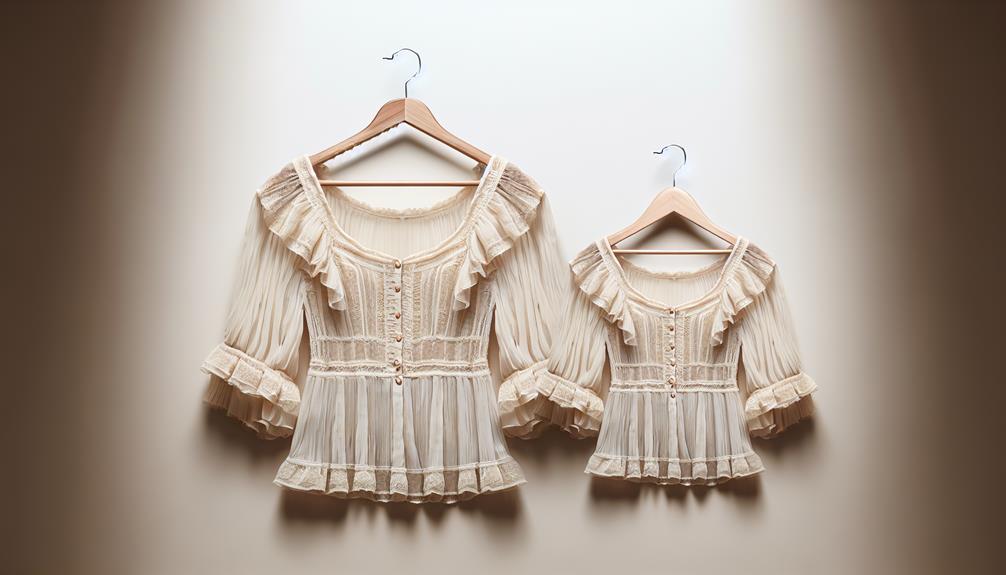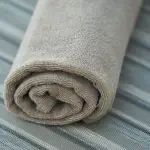Yes, chiffon can definitely shrink. It largely depends on the fabric blend and how it's treated. Silk chiffon, being a natural fiber, is particularly prone to shrinkage, especially when exposed to heat. Polyester chiffon is tougher, but still, better safe than sorry. For any kind of chiffon, you need to wash it gently, avoiding hot water and harsh detergents. Always air dry and iron cool with a protective cloth. Handling it correctly is key. There's also some neat tricks on caring for chiffon to keep it in pristine condition, which you might find pretty handy.
Table of Contents
Key Takeaways
- Chiffon can shrink, especially silk chiffon, due to its natural fiber composition.
- Exposure to high heat during washing or ironing increases the risk of shrinkage.
- Polyester chiffon is less prone to shrinkage due to its synthetic nature and durability.
- Improper drying techniques, like using excessive heat, can also lead to chiffon shrinkage.
- Gentle handling, including cold water washing and air drying, minimizes the risk of shrinking chiffon.
Understanding Chiffon Fabric
Chiffon is a light, sheer fabric often used in elegant clothing like evening dresses and scarves. It's got this unique, almost ethereal appearance that makes it a favorite for flowy, delicate designs. Now, when you're dealing with chiffon, you're not just handling a fabric; you're dealing with a material that demands respect and care. Chiffon's lightness comes from its fine threads and tightly twisted yarns, which contribute to its slightly rough feel and sheer appearance.
Handling chiffon can be tricky. It's not just about throwing it into the wash and hoping for the best. You've got to be gentle. When I wash chiffon, I always use cold water and a mild detergent, and I never wring it out. Instead, I'll gently squeeze the water out and lay it flat to dry. This helps to maintain its shape and integrity.
Ironing chiffon is another area where you need to be cautious. I always set the iron on a low heat setting and use a pressing cloth between the iron and the fabric. This prevents the heat from damaging the delicate threads. Every step in caring for chiffon needs careful consideration to keep its elegant appearance intact.
Types of Chiffon Materials
Now let's look at the different types of chiffon materials.
You've got silk chiffon, which is known for its luxurious feel and delicate nature.
Then there's polyester chiffon, which is much tougher and often used because it's more durable.
Silk Chiffon Characteristics
Silk chiffon, often praised for its elegance, is a lightweight fabric that beautifully combines sheerness with a soft finish. It's one of those materials that you can't help but adore for its luxurious feel and flowy nature.
Here's what makes silk chiffon stand out:
- Natural Fiber: Silk chiffon is crafted from natural silk fibers, making it incredibly soft and comfortable against the skin.
- Breathability: Despite its delicate appearance, silk chiffon is highly breathable, perfect for warm weather or layered styles.
- Versatility: Ideal for everything from scarves to evening gowns, its versatility is unmatched.
Understanding these characteristics can help you appreciate why silk chiffon remains a favorite for high-fashion designs and elegant drapery.
Polyester Chiffon Durability
Turning our attention to polyester chiffon, we find it's notably durable and resilient, ideal for frequent use. This synthetic fabric boasts a high resistance to wear and tear, making it a top choice for garments that need to withstand regular handling and washing. It's less prone to shrinking compared to natural fibers, which is a big plus if you're not into high-maintenance clothes.
Here's a quick snapshot of polyester chiffon's key attributes:
| Feature | Benefit | Ideal Use |
|---|---|---|
| High Durability | Resists wear, maintains shape | Daily wear outfits |
| Low Maintenance | Easy to wash, dries quickly | Busy lifestyle |
| Wrinkle Resistant | Minimal ironing needed | Travel and on-the-go apparel |
| Cost-effective | Affordable, offers value for money | Budget-conscious shopping |
As you can see, polyester chiffon is an all-rounder, meeting the demands of both durability and practicality.
Blended Chiffon Varieties
Exploring blended chiffon varieties reveals a fascinating mix of materials, each offering unique benefits and characteristics. Here's the lowdown on three popular types:
- Silk-Polyester Chiffon: This blend combines the luxury of silk with the durability of polyester. It's less prone to wrinkling and easier to handle than pure silk chiffon, making it a go-to for both high-end and practical garments.
- Cotton-Silk Chiffon: Ideal for those who prefer natural fibers, this blend offers the softness of cotton with the sheer, airy qualities of silk. It's breathable and perfect for warmer climates.
- Nylon-Spandex Chiffon: For those needing stretch and flexibility, this mix includes spandex. It's excellent for active wear or flowy dresses that need to move with you.
Common Causes of Shrinkage
Chiffon can shrink when exposed to heat, especially during washing or drying. But that's not the only cause. Let's dive into why this happens and how you can avoid it.
First off, it's essential to understand that chiffon is generally made from silk, polyester, or a blend of both. Silk chiffon is more delicate and prone to shrinkage compared to its polyester counterpart, mainly because silk is a natural fiber. Natural fibers have this tendency to react more dramatically to temperature changes. They absorb more water, which swells the fibers, and when heated, they can contract.
Another common cause is incorrect ironing techniques. High temperatures on a delicate fabric like chiffon? That's a recipe for shrinkage. The fabric structure can tighten up significantly if the iron's too hot.
Also, let's not forget about the mechanical action during dry cleaning. While dry cleaning is often recommended for delicate fabrics like chiffon, the chemicals and agitation involved in the process can sometimes lead to shrinkage if not done properly.
Understanding these causes helps you care for chiffon garments better. Remember, it's all about managing the exposure to heat and handling the fabric with care.
Washing Chiffon Properly
Now that we understand the common causes of chiffon shrinkage, let's discuss how to wash it properly to avoid these issues. Washing chiffon isn't as daunting as it sounds, but it does require a gentle touch and the right approach. Here's how I tackle it:
- Choose the Right Detergent
Opt for a mild detergent specifically designed for delicate fabrics. Harsh chemicals can damage chiffon's fibers. I use just a teaspoon of detergent in a sink full of cold water — this is plenty to get the job done without causing harm.
- Hand Wash Gently
Avoid tossing your chiffon garments into the washing machine. Instead, gently swish them around in the sink. I always treat my chiffon like a delicate flower, using soft, tender movements to avoid stretching or tearing the fabric. It's all about being careful.
- Rinse Thoroughly
After washing, I ensure to rinse the fabric thoroughly with cold water to remove any soap residue. Soap left on the fabric can attract dirt and might even contribute to wear and tear over time.
Drying Techniques for Chiffon
After washing, it's crucial to dry chiffon carefully to maintain its shape and texture. Here's how I handle it to avoid any disasters—because we all know how finicky chiffon can be!
First off, never wring out chiffon; it's a surefire way to damage the fabric. Instead, after rinsing, I lay the garment flat on a clean, dry towel. I roll the towel up with the chiffon inside, pressing gently to absorb excess water. Think of it as a chiffon-towel sushi roll!
Now, when it comes to actually drying chiffon, air drying is your best friend. I always hang the garment on a well-shaped hanger or lay it flat on a drying rack. Direct sunlight and heat can be the enemies here, so I find a nice shady spot indoors.
Check out this quick guide:
| Method | Tips |
|---|---|
| Towel Roll | Roll, don't twist; gently press |
| Hanging | Use a padded hanger; avoid direct sun |
| Flat Drying | Smooth fabric; choose airy, cool space |
These methods keep my chiffon looking flawless without shrinking or warping. Patience is key—let the fabric dry naturally, and you'll preserve its delicate beauty.
Ironing Tips for Chiffon
When it comes to ironing chiffon, you've got to be careful.
First off, always pick the right heat setting because too much heat can damage the fabric.
And don't forget to lay a protective pressing cloth over your chiffon to avoid any direct contact with the iron.
Select Appropriate Heat Setting
Choosing the right heat setting on your iron is crucial when working with chiffon to avoid damage. Here's how I make sure I get it just right:
- Check the Label: Always start by checking the garment's care tag. Most chiffon should be ironed on a low heat setting.
- Test First: I always test the heat on a small, hidden part of the garment. This way, I don't risk ruining the whole thing.
- Adjust as Needed: If the chiffon doesn't respond well, I adjust the heat slightly. It's about finding that sweet spot where the fabric smooths without scorching.
Use Protective Pressing Cloth
To protect the delicate fabric of chiffon, I always use a pressing cloth while ironing. This simple step is a game changer. The cloth acts as a barrier between the iron and the chiffon, preventing those nasty scorch marks and overly shiny spots that can easily ruin the material's subtle sheen. I recommend using a thin cotton or muslin cloth because they're breathable and ensure heat distributes evenly without damaging the chiffon.
Don't just grab any fabric lying around; make sure it's clean and free of any textures or patterns that could inadvertently transfer onto your chiffon. This precaution keeps your fabric looking pristine and extends its life significantly, especially when you're dealing with such a temperamental material.
Gentle Pressing Techniques
I always set my iron to a low heat setting when pressing chiffon to avoid damaging the delicate fabric. It's crucial to handle this material with care to maintain its elegant appearance.
Here are a few tips I follow to ensure my chiffon looks flawless without risking harm:
- Test First: Before I start, I always test the iron on a small, inconspicuous part of the fabric. This step ensures that the heat won't cause any unexpected changes.
- Use Steam: I prefer using light steam to help remove wrinkles without direct contact. It gently eases out creases without pressing too hard on the fabric.
- Quick Movements: I keep the iron moving constantly. Lingering too long in one spot can lead to heat marks or even burn the chiffon.
Handling Mixed Fiber Chiffon
Handling mixed fiber chiffon requires careful attention to washing and drying techniques to prevent shrinking. When you're dealing with a blend of fibers like silk and polyester, or nylon and rayon, you've got to consider both the strengths and weaknesses of each material. I always start by checking the care label—this tiny tag is your best friend for keeping your delicate fabrics in top shape.
If the label says hand wash, stick to it. I use cold water because hot can be harsh on mixed fibers, making them more prone to shrinkage. I add a mild detergent, swirl it around gently, and let the garment soak for a few minutes. It's tempting to wring it out, but I just press the water out softly instead. Trust me, it helps maintain the fabric's integrity.
For drying, I stay away from the dryer. Heat's not a friend of chiffon, especially the mixed types. I lay the piece flat on a clean towel, roll it up to absorb the moisture, and then let it air dry on another dry towel, away from direct sunlight. This method helps keep its shape without the risk of shrinking.
Professional Cleaning Advice
Although you can manage a lot at home, sometimes taking your chiffon to a professional cleaner is the safest bet. I've learned this the hard way after a couple of mishaps. When you're dealing with delicate fabrics like chiffon, the expertise of a professional can really make a difference, ensuring that your garments are treated correctly without damaging the material or altering its shape.
Here's why I opt for professional cleaning:
- Expertise in Handling Delicate Fabrics: Professional cleaners have the right tools and knowledge to handle delicate fabrics like chiffon. They understand how to treat different types of chiffon, whether it's silk-based or synthetic, to prevent damage and shrinkage.
- Appropriate Cleaning Solvents: They use solvents that are gentle yet effective. These are specifically designed for delicate fabrics, which helps maintain the integrity and beauty of chiffon without causing shrinkage.
- Advanced Techniques: Professionals employ techniques like steaming and dry cleaning that are ideal for delicate fabrics. These methods help keep chiffon looking its best, ensuring that it doesn't lose its sheen or texture.
For anyone serious about maintaining their chiffon in top-notch condition, trusting a skilled professional is definitely worth considering.
Storing Chiffon Garments
Now that we've covered how to clean chiffon, let's talk about how to store it properly.
I'll show you how to fold your chiffon garments to avoid wrinkles and discuss the best conditions to keep them looking great.
We'll also talk about how to protect them from humidity, which can really mess them up.
Proper Folding Techniques
To keep your chiffon garments in top shape, it's crucial to master proper folding techniques. Chiffon can be finicky, so handling it the right way ensures it stays beautiful and wrinkle-free.
Here's how I do it:
- Lay Flat: Start by laying the chiffon garment flat on a clean surface. Smooth out any wrinkles with your hands gently.
- Fold Gently: Fold the garment inwards from the sides, then from the bottom up, avoiding harsh creases. Think soft, loose folds.
- Roll Softly: If space allows, gently roll the garment instead of folding to minimize creases even more.
This method has saved my chiffon pieces from turning into a wrinkled mess!
Ideal Storage Conditions
After mastering how to fold chiffon, it's equally important to know the best ways to store these delicate garments. You'll want to keep your chiffon items in a cool, dry place. I personally recommend using a closet that doesn't get too hot or receive direct sunlight, as extreme temperatures can harm the fabric.
Make sure you use padded hangers to avoid creases and maintain the garment's shape. If drawer space is your only option, place acid-free tissue paper between each folded piece to prevent any color transfer or snagging.
Also, don't overcrowd your chiffon items; they need a bit of breathing room to stay in pristine condition. Proper storage really extends their life and keeps them looking their best.
Avoiding Humidity Damage
Keeping chiffon away from humid conditions is crucial to prevent mold and fabric damage. Here's how I make sure my delicate chiffon pieces stay pristine:
- Use Silica Gel Packs: I toss a few silica gel packs into my chiffon storage boxes. They're great at sucking up any excess moisture.
- Maintain Air Circulation: I never squash my chiffon items in a cramped closet. Instead, I hang them in a spacious area or store them in breathable garment bags to ensure good air flow.
- Monitor Humidity Levels: I've got a small hygrometer in my closet to keep tabs on the humidity. If it creeps up, I turn on a dehumidifier to nip any potential moisture problems in the bud.
Common Mistakes to Avoid
When caring for chiffon, many people often make the mistake of using high heat in washing or drying. I've learned that this practice can seriously harm the delicate fibers, causing them to shrink or even melt. Here's a quick table that highlights some common errors and better practices:
| Common Mistakes | Better Practices |
|---|---|
| Using hot water | Opt for cold or lukewarm |
| Drying on high heat | Air dry or use low heat |
| Aggressive wringing | Gently press out water |
It's crucial to remember that chiffon is more fragile than your average fabric. Another error I've seen is the rough handling during washing. Instead of scrunching or twisting the garment, which can lead to tears or misshaping, gently swish the fabric in water.
Also, many skip using a mesh laundry bag. This simple tool can prevent your chiffon from snagging or tangling with other items, preserving its structure and appearance. By steering clear of these common mishaps, you can keep your chiffon items in pristine condition for a longer time, avoiding unnecessary damage and extending the life of your garments.
Repairing Shrunken Chiffon
Despite our best efforts, chiffon can sometimes still shrink; here's how you can try to repair it. I've had my share of oops moments with chiffon, and I've picked up a few tricks to coax it back into shape. Let's break down the steps:
- Moisture is Key: Start by damping your chiffon fabric. Use a spray bottle to lightly mist it with water, but don't soak it. This slight dampness will help the fibers relax and become more pliable.
- Gentle Stretching: Lay the fabric flat on a towel. Carefully stretch the fabric from different angles. Don't pull too hard; chiffon is delicate. Gradually work your way around the fabric, easing it back towards its original size. This process might take a bit of patience, so don't rush.
- Air Dry Properly: Once you've achieved some improvement, pin the fabric to the towel and leave it to air dry. Avoid hanging chiffon when it's wet as gravity could stretch it unevenly or cause it to lose its shape further.
I hope these steps help you salvage your shrunken chiffon! Remember, it's about gentle, patient restoration. Good luck!
Extending Chiffon Lifespan
To extend the lifespan of your chiffon garments, it's crucial to follow specific care guidelines. First off, always check the label. Sounds obvious, right? But really, it'll tell you whether to hand wash or machine wash. I recommend hand washing with a gentle detergent. It's softer on the fabric and preserves its delicate structure.
When drying, avoid wringing out your chiffon. Instead, lay it flat on a towel and roll it up gently to absorb the excess water. Then, air dry it away from direct sunlight to prevent fading and weakening of the fibers. Ironing? Set your iron on low heat and use a pressing cloth between the iron and the chiffon. This prevents direct contact and potential scorch marks.
Storage is another key aspect. Don't just toss chiffon into your drawer. Hang it on padded hangers or store it in a breathable garment bag. This avoids creases and stress on the fabric.
Frequently Asked Questions
Can Chiffon Be Dyed at Home Without Altering Its Texture?
Diving into DIY, I've found that you can dye chiffon at home, but it's a delicate dance. Using the right dye and technique ensures the fabric's texture remains as soft as a cloud.
How Does Sunlight Exposure Affect Chiffon Fabric Over Time?
Sunlight exposure can degrade chiffon fabric, causing it to fade and weaken. I've noticed colors become less vibrant and the material less resilient, which affects its drape and overall appearance over time.
Are There Hypoallergenic Considerations When Wearing Chiffon?
I've found that chiffon's generally safe for allergy sufferers, but it's always smart to check the fabric blend. Some chiffons include allergenic fibers, so it's crucial to know what you're wearing.
What Are Eco-Friendly Alternatives to Traditional Chiffon?
I've explored eco-friendly alternatives to traditional chiffon. Options like organic silk chiffon and recycled polyester provide sustainable choices without sacrificing quality, offering those of us interested in eco-conscious fashion viable, greener substitutes.
Can Chiffon Garments Be Recycled or Repurposed Effectively?
Yes, chiffon garments can be recycled or repurposed effectively. I've seen them turned into art projects, new clothing items, and even household decorations, which helps reduce waste and promotes sustainable fashion practices.
- Lacoste’s Gabardine Cap: The Story Behind the Iconic Croc - June 24, 2025
- The History and Style of the 1940s Gabardine Ricky Jacket - June 24, 2025
- The Best Women’s Gabardine Trousers for a Polished, Professional Look - June 24, 2025







